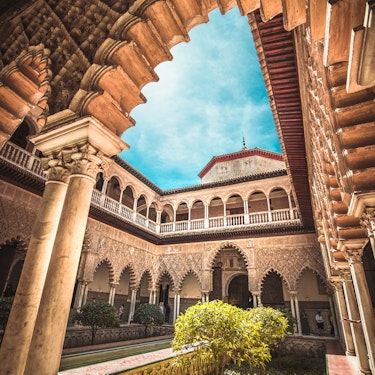More about: Best Things to Do In Seville In 1 Day
Although one day may not seem long enough for everything there is to see and do in Seville, believe me it's enough time to visit the must-see places. To help you out, I've made a list of those places that I wouldn't want to miss (and I'm sure you wouldn't either) for their historical, artistic and cultural value.
Many of these places will surely ring a bell as their fame goes beyond Seville's borders: the Giralda, the Real Alcázar, the Torre del Oro, the Triana neighbourhood... Through them all you can not only learn about the origins of the city, but also discover its most authentic colour, flavour and art.
Start the day visiting the Cathedral of Seville, the great gothic temple.
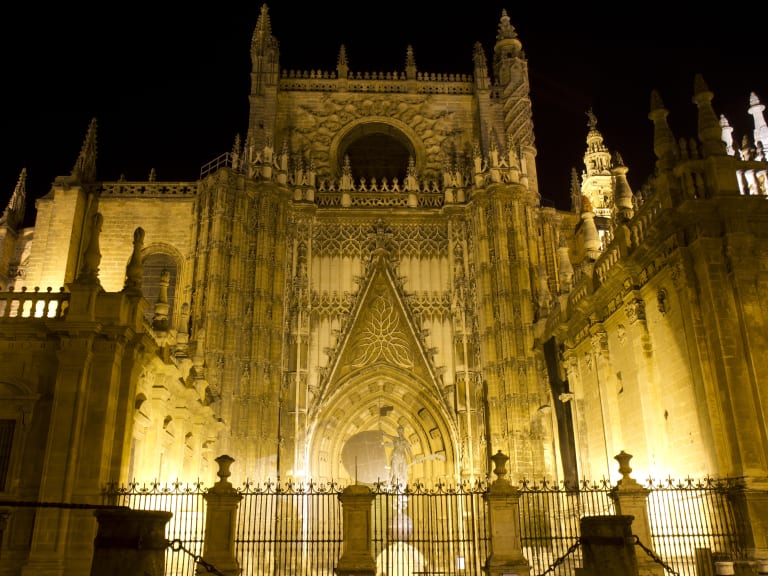
I'm not going to deceive you, as soon as you set foot in Seville you will realise that, architecturally speaking, it is one of the most interesting cities in Spain. One of the most important buildings is the Cathedral of Seville, the largest Gothic temple in the world. Of course, before it was a place of Christian worship it was a mosque.
Entrance costs approximately 11€, although it is more interesting to buy the visits to the Cathedral, the Giralda and the Alcázar of Seville together (more or less 45€).
The Cathedral of Seville has 10 doors, but it is normal to enter through the main one: the Puerta de la Asunción. Once inside, take a leisurely stroll around the 400-square-metre main altarpiece and the tomb of Christopher Columbus, who was buried here with full honours.
Before you leave, take a breath of fresh air in the beautiful Patio de los Naranjos, one of the few remaining elements of the old mosque. You can also take a walk on the roof of the Cathedral to see Seville from above, but the Giralda is a much better vantage point.
Interesting facts
- Where: Avenida de la Constitución s/n
- Price: approximately 11€ (includes the Giralda)
- Recommended if: you want to see inside one of the largest religious temples in the world.
Before leaving the Cathedral, climb to the top of the Giralda

Included with your ticket to the Cathedral (approximately 15€) is the chance to climb the Giralda, the Christian bell tower which was once the minaret of the Almohad mosque; this mix of cultures is reflected in the architecture itself, with the lower part of the tower being Almohad and the upper part Christian.
You can thank King Alfonso X that it still exists, as in the 10th century when the Muslims were defeated they wanted to demolish the tower so that it would not become Christian.
It is 101 metres high, so be prepared for a somewhat tiring ascent. However, instead of steps, you will have to climb up 35 ramps. The reason? The sultan had to be able to climb with his horse. The effort will be worth it when you see Seville and all its colour at your feet.
As well as climbing the Giralda, I recommend you stay in the surrounding area when it gets to 12 noon. That way you will be able to hear its 24 bells calling the faithful to prayer.
Interesting facts
- Where: Avenida de la Constitución s/n
- Price: approximately 11€ (included with the entrance to the Cathedral).
- Recommended if: you want to see the centre of Seville from above.
Discover palace life at the Real Alcázar of Seville
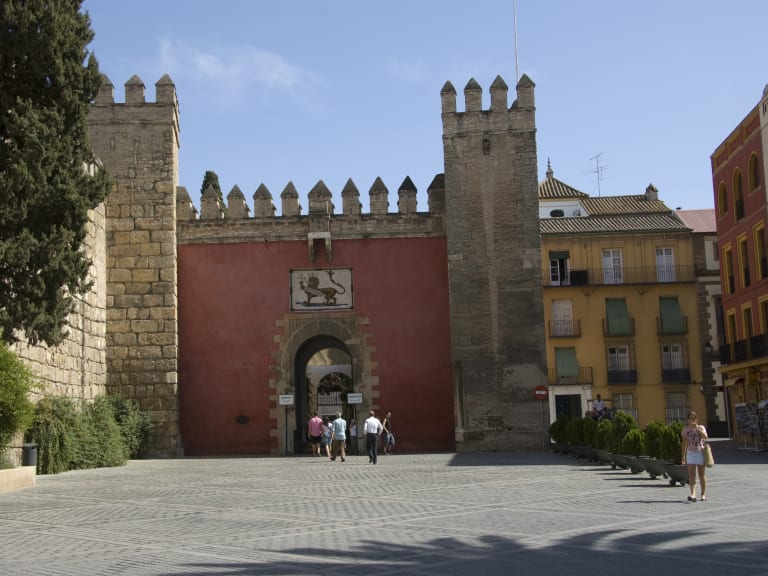
To enter the Real Alcázar of Se ville you can buy your ticket together with the entrance to the Cathedral and the Giralda (about 45€) or individually (about 13€). This is also very convenient because the entrances to both sites are next to each other, just 1 minute away.
Either way, be prepared for a tour of one of the best-preserved palace complexes in the world. It has been declared a World Heritage Site by UNESCO, and no wonder: artistic elements from the Islamic, Mudejar, Gothic, Renaissance, Baroque and even Mannerist periods coexist in this complex.
Visiting the Alcázar of Seville is to become aware of the multiculturalism that has always been present in the city. You will visit the Mudejar Palace of Pedro I, but also the Gothic Palace, as well as its marvellous Gardens, which are full of fountains, ponds and sculptures.
Interesting facts
- Where: Patio de Banderas, s/n
- Price: approximately 15€.
- Recommended if: You like architecture and a mixture of decorative styles.
Enter the documentary treasure trove of the Archive of the Indies

When you leave the Alcázar, you only have to walk a minute to the Archive of the Indies, a place where all the information about the Spanish colonies in America and the Philippines is centralised.
Seville was a strategic place; through the port of the Guadalquivir many ships came and went, so the city was full of sailors, conquistadors and a lot of documentation.
Today this place can be visited free of charge and is a sort of museum full of historical treasures, such as personal diaries and handwritten texts of Christopher Columbus or Hernán Cortés, among others. In total, there are an estimated 43,000 folders, with some 80 million pages and 8,000 maps and drawings.
Interesting facts
- Where it is: Av. de la Constitución, s/n
- Price: free access
- Recommended if: you like history
Take a lunch break and stroll through María Luisa Park, the lungs of Seville
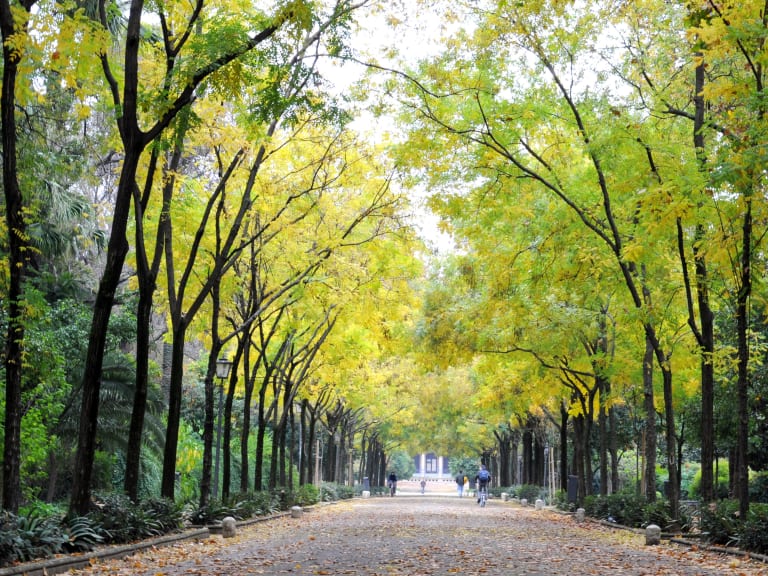
The Archivo de Indias is very close (just a 15-minute walk) to the Parque de María Luisa, a perfect place for a picnic, a stroll or to start a bike tour of Seville.
Many years ago this was not possible, as the park was privately owned and belonged to the Palacio de San Telmo (the city's former seminary). Fortunately, nowadays it is a public park where you can find monuments and historical buildings but also a lot of vegetation.
A stroll through the Parque de María Luisa means accepting the possibility of getting lost, although it is not a bad plan either. Accompanying the different species of trees there are many ponds and even a small artificial mountain (the Gurugú) where you can climb to relax.
The whole landscaping project was carried out less than a century ago for the celebration of the Universal Exhibition of 1929. Thanks to this, the park, which was somewhat neglected, was filled with plants, many of the fountains that are there now were built and it was also reorganised along 3 main axes or avenues.
Interesting facts
- Where: it forms its own neighbourhood in the southern district of Seville.
- Price: free and open access
- Recommended if: you fancy a picnic or a stroll through nature
Take a break in the Plaza de España before continuing your day.

Although there are other squares in Seville that have more history because they have been there since the beginnings of the city, the Plaza de España, located in the Parque de María Luisa, is one of the most recognisable.
It was designed and built for the Expo of 1929, so it has a modern feel to it. However, what stands out here is the set of 48 benches decorated with tiles that tell the history of Spain and its provinces.
In addition to the benches, which have become a symbol of the city and the country, you should also take a look at the two towers at either end of the building that presides over the square. They are baroque in style and immense, each more than 70 metres high.
Another remarkable element is the 500-metre-long canal that crosses the space and along which small boats circulate.
Interesting facts
- Where: in the María Luisa Park.
- Price: free admission
- Recommended if: You want to sit down for a while and relax in an emblematic part of the city.
Look out over Seville and the Guadalquivir from the Torre del Oro (Golden Tower)

A 20-minute walk along the banks of the Guadalquivir from the Plaza de España is another of Seville's landmarks: the Torre del Oro (Gold Tower).
This old defensive construction (hence its location next to the port of the Guadalquivir) has been converted into one of the city's best viewpoints (as well as housing the Naval Museum). It costs about 3€ to enter and climb to the top (it's over 30 metres), so don't miss this visit.
Although this tower was erected to protect Seville, there are legends that say it was also the place where the king took his mistresses.
Whether you believe that story or not, today you can visit it for an incredible panoramic view from the top of its terrace and to see the Naval Museum's collection, which explains how important the river and navigation are to the city.
Interesting facts
- Where: on Paseo de Cristóbal Colón, s/n, on the banks of the Guadalquivir.
- Price: approximately 3€.
- Recommended if: you want to contemplate the Guadalquivir and Seville from its terrace.
Walk along the Paseo de Cristóbal Colón to the Puente de Triana and see the two Sevillas

Leaving the Torre del Oro behind, continue walking along the Paseo de Cristóbal Colón (the bank of the Guadalquivir) to the Puente de Triana, also called Puente de Isabel II, the oldest bridge in Seville.
It was built in 1852 and before that there had only been a provisional, unstable bridge. Its construction was important because it united the two Sevillas, which had previously been divided by the river.
Although nowadays there are more bridges to cross the river, this one has never ceased to be the most popular and preferred by the Sevillians. Somehow it has become a symbol of union that allowed Seville to be one.
When you cross it, stand right in the middle and look both ways; you will have beautiful views of the city, both of the historic centre (where you are coming from) and the Triana neighbourhood (your next destination).
Interesting facts
- Where: starts at the intersection of Paseo de Cristóbal Colón and Calle Arjona.
- Price: free and open access
- Recommended if: you want to see the two Sevillas and how they came together.
Experience the most authentic Seville in the Triana neighbourhood
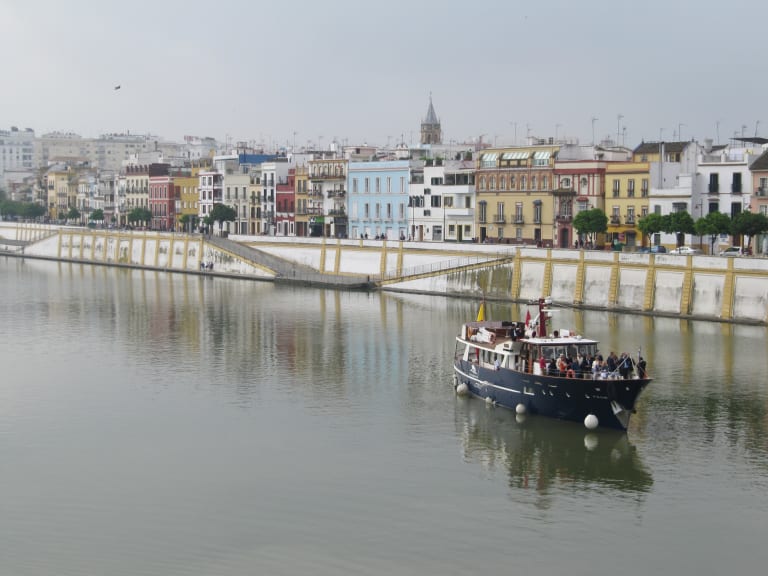
If I had to make a list of the best neighbourhoods in Seville, one of the first places would go to the Triana neighbourhood.
Crossing the Guadalquivir River over the bridge of the same name, you come to this artistic area of the city. Its history dates back to Roman times, as it was a place of settlement for the legionaries, and its culture is closely linked to the river.
There is much to see in Seville's Triana neighbourhood, but my advice is to stroll through its streets and make your way to those places that make it so special, such as Calle Betis and its colourful houses or the Capilla del Carmen.
The artistic wealth of the neighbourhood is due to the fact that many singers and dancers were born here, but also to its lively atmosphere.
Triana is also a good place to eat, either in its Market, where you will find stalls serving typical dishes or selling fresh produce, or on one of the best tapas tours in Seville, as there are traditional taverns here, where the flavour is authentic.
Interesting facts
- Where: it is a neighbourhood on the right bank of the Guadalquivir.
- Price: free admission
- Recommended if: you want to discover the most authentic Seville.
End your day enjoying music, dance and art in a flamenco tablao

If there is a place to experience flamenco, it is the Triana neighbourhood. The also called cante jondo is much more than live music; on the tablaos there is a lot of emotion and feeling, something you will notice the moment you go to a flamenco show in Seville (approximately 20€).
Seville is also one of the places where it was born; at first it was a small gathering of family and friends, but over the years it became quite a spectacle and found its way into theatres. However, it has always tried to maintain its intimate character.
Nowadays flamenco continues to impress everyone who goes to a tablao. There you can understand the value of this art form, although if you want to know more about its history I highly recommend a visit to the Flamenco Dance Museum of Seville (entrance costs approximately 10€), where there are interactive exhibitions that take you through its past and present.
Interesting facts
- Where: different locations in Seville (mainly Triana neighbourhood)
- Price: approximately 20€.
- Recommended if: you are a flamenco lover and want to experience it up close.
The tourist bus: the best way to get around Seville during the day

In general, you could say that Seville is a city that is easy to get around on foot. However, if you're only staying for a day, you might want to get from one place to another and not waste too much time. The solution? Take a tourist bus around Seville. They are a comfortable alternative and, unlike public transport, only make stops at important places.
The price for one day is approximately €23 and all transfers are included. In other words, you can get on wherever you want and get off at each tourist attraction.
A new bus runs every half hour or so, so you'll have no problem getting to places like the Plaza de España or the Torre del Oro. They also include a guide to help you learn about what you're going to see.
A day in Seville can be a long day, so organise your day well and visit all the must-see places.

